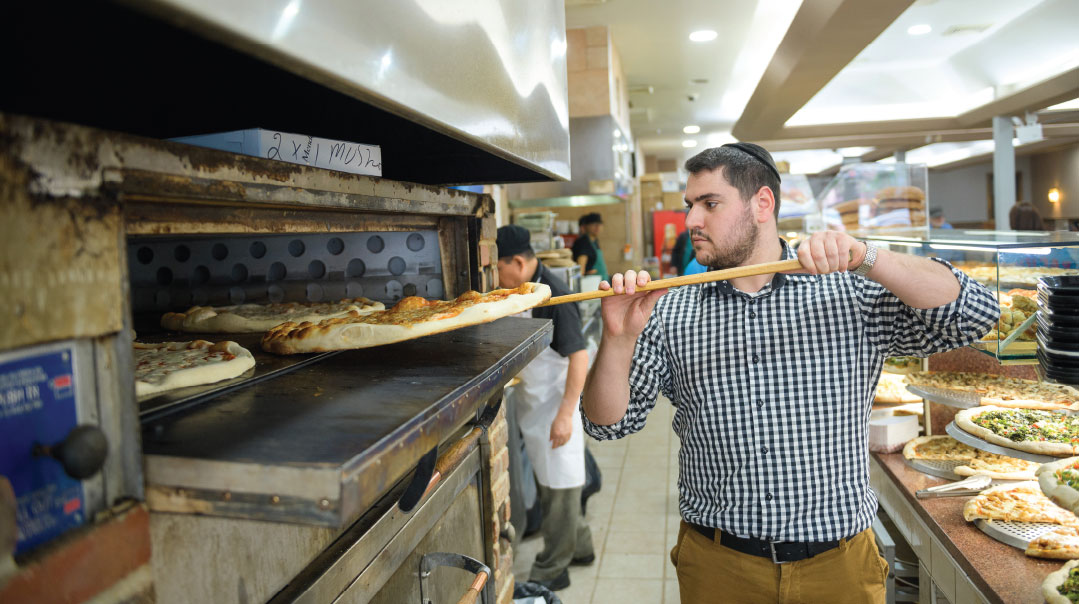A Modest Proposal

The unspoken question practically shouts out loud: Is there another way?

Faced with the increasingly untenable situation of expenses most families can’t handle, coupled with undue pressure on both hosts and guests, some people are rethinking the way we make weddings. Does the meal really have to be set up for hundreds, many of whom would rather be somewhere else or who don’t even show up? Is it possible to trim down without losing out?
When my first son got engaged a year and a half ago, I told the diamond dealer, “No wimpy little stone for us.” He looked at me with wise eyes and said, “You have seven sons — be careful of the trend you’re setting.” He knew a thing or two, of which I was blissfully unaware. I wanted that large diamond and could afford it, so I waved away his words of caution.
We were in the process of buying a summer home at the time, and we devised a solid, responsible financial plan for covering both the house and wedding costs. My husband is an accountant in a midsize firm, I’m a physical therapist, and we’d never been lacking. Even now, with these big expenses, our bases seemed covered.
In our circles, wedding costs are split 50/50 between the chassan’s and kallah’s families. Our mechutanim are part of a tight-knit social circle for whom image is paramount, and fitting in seems to override financial practicality. With each upgrade they presented us — the flowers, the music, the menu — we nodded our heads agreeably, scared to make waves, but we slowly realized we were on a speeding train on a first-class ride we couldn’t afford. My husband and I aren’t driven by social pressures, but ironically, we spent money we couldn’t spare to help our mechutanim maintain their desired image.
Sheva brachos ended on Shabbos, and my daughter got engaged the following Tuesday. The second mechutanim were a little lower key, but were also wealthy and used to doing things on a high standard. Call us weak, but once again we agreed to every upgrade they requested.
By then we were seriously overextended. We began dipping into savings we vowed to never touch. I loaded my schedule with as many PT cases as I could physically handle, working myself to the bone. The stress kept rising, and I became angry at myself for feeling anxious and frazzled instead of enjoying the simchah.
I had eight kids to take care of, including a baby; Pesach was approaching; and we had a wedding to plan. Then my husband’s mother had a stroke and her care fell on his shoulders — suddenly he was never around. My responsibilities were crushing me, and I felt like I was choking. I knew that I needed to stop working in order to regain control of my life. But the bills… the bills! I saw them in my sleep. And so instead of cutting back on work, I took on even more.
The second wedding took place four months ago, but the tightness in my chest hasn’t yet eased. Paying off our wedding has meant begging for delays with other payments. This is a new reality for us, one which I find myself obsessing over. Sometimes I tell myself we just need a few months and things will return to normal. Other times I wake my husband in the middle of the night and frantically ask him, “What are we going to do?”
Chaya’s story of quiet desperation is the all-too-common outcome for many families who get by, or even manage well, up until they start marrying off children. “If we’d the ability to save even a few thousand dollars at each of my weddings, the knot we felt in our kishkes would have been that much less,” she says.
The unspoken question practically shouts out loud: Is there another way?
Cutting Back
This question has, in fact, been extensively studied by community-conscious askanim all over the Jewish world, leading to the rise of wedding packages and takanos. But a group of women in Toronto, who for the past ten years have been designing and implementing wedding packages for people in their community interested in spending less, say it’s time to break new ground.
“Over the years, we’ve developed a broad and detailed view of the current wedding dynamic,” says Esther Heller, a leader of the Toronto innovators.
The two main groups who create the dynamic of any wedding, Esther says, are the baalei simchah and the guests; both of these groups face pressures that need to be alleviated.
In the current system, the baalei simchah’s guest list includes the people on their block, coworkers, everyone they carpool with, their bungalow colony circle, and those they daven alongside. Names are added to the list accompanied by a sinking feeling and a helpless shrug: This is ridiculous, but what choice do I have? This is how it’s done. Fear of insulting anyone rules.
On the other end, the carpoolers, neighbors from the other end of the block, and summer-only friends open their invitations and groan. Another night away from the kids, another missed night seder. This is ridiculous, but what choice do I have? This is how it’s done. Fear of insulting the baalei simchah rules.
And so, blowing through more than one can reasonably afford, for a single night’s optics, is standard. A not-insignificant number of reserved guests are no-shows or leave before the meal, wasting money that could’ve been used a hundred different ways. In places where parking is difficult, couples give up their evening and drive across town only to take turns running in to wish mazel tov (while trying to make it look like they’re staying). While everyone enjoys a simchah, there’s also widespread agreement that today’s weddings come with excessive waste of money, effort, and time.
Esther and her partners believe they have an idea whose time has come.
“Millions of dollars are donated every year to cover wedding costs for needy families. I’ve seen firsthand how most of that money goes to support the simchah industry. My husband asked a sh’eilah if such donations, which end up in the pockets of florists and caterers, can even be considered tzedakah. The rav’s response was that it can, quoting the Chofetz Chaim who says that tzedakah means helping a person live within society’s norms, even if that goes beyond essentials. So the real question becomes, are these valid norms?
“When it comes to bar mitzvahs, people have options. They can make a lavish dinner, a toned-down kiddush, or take a trip to Eretz Yisrael,” Esther says. “Yet when it comes to weddings, we’re so entrenched in the same format: smorgasbord, badeken, chuppah, seudah interspersed with dancing. What would happen if we shook that up?”
Times are Changing
Consider the following wedding schedule:
6:00 | Kabbalas Panim/Chassan tish – light refreshements (e.g. cake and drinks). All wedding guests welcome.
6:20 | Badeken. All wedding guests welcome.
6:30 | Chuppah. All wedding guests welcome.
7:00–8:30 | Buffet and first dance. All wedding guests welcome.
8:30 | Wedding itself ends.
8:45 | Sheva brachos seudah begins, for closest family, friends of the chassan and kallah, and out-of-town guests only (your Shabbos sheva brachos guest list would be a good yardstick), followed by second dance.
The biggest upside of this format, Esther says, is that the number of dinner guests is dramatically cut, which can result in significant money saved: not just fewer meals, but also fewer flowers/centerpieces (cocktail tables would suffice, as in a typical smorgasbord), and potentially smaller wait and kitchen staff. Smaller, less expensive halls become a tenable option. (This is sort of an inverted version of many low-budget Israeli weddings, where only family and close friends attend the seudah, and everyone else comes in between nine and ten p.m. to say mazel tov and have some refreshments from the buffet.)
Serving just one course at this sheva brachos seudah is more than adequate, since it’s coming after a buffet. Dessert from the buffet can stay open and do double-duty after the seudah.
Guests who are less close and invited only to the chuppah and buffet won’t feel as obligated to come, a win for them as well. And for those who prefer to spend the evening at home and pop over at 10 p.m. to wish mazel tov — the baalei simchah will be delighted to see them as well, and they can catch the second dance.
Like at any wedding, pictures of the chassan and kallah can be done immediately after the chuppah, while guests enjoy the buffet. Or for those who prefer not to keep their guests waiting, pictures can be taken between the wedding and sheva brachos, as long as nobody minds a little shvitz.
There are inherent challenges in this format, Esther admits, but says that none are insurmountable and they’re offset by the gain.
While the earlier hour of such a wedding means that some guests won’t make it in time for the chuppah, the people most important to the chassan and kallah will make sure to be there, and the buffet and sheva brachos seudah will end at a reasonable time.
The younger generation needs to be included in this conversation — chassanim and kallahs often place pressure on their parents to do things just like their friends do.
“A kallah might resist the idea out of concern that the second dance will be ‘nebby’ with such a small crowd, or that after dancing with her mother and mother-in-law at the first dance, she’ll be dancing next with the second cousins, neighbors, and other acquaintances, while the closer people, those invited to the meal, will only get the second dance,” Esther notes. “But you can point out to her that if you look around at a typical second dance, the people in the room are, for the most part, the very same people you’d have on your minimized dinner list.”
Viewing this, and other likeminded initiatives, as a solution only for those looking for the cheapest option out there would be its own death knell. Because the key to its widespread acceptance is starting at the top. “It’s a concept that makes sense for everyone, and wealthier people taking the plunge will give permission to those of lesser means to feel comfortable with it as well,” says Esther.
This initiative will actually have the biggest impact on those in the middle of the economic spectrum, who want to make a respectable wedding but without the financial agita. There are community resources devoted to those in real need, she says, but it’s the average folks who struggle with wedding costs the most.
“We need people who believe in the cause to step up to the plate. We’ve spoken to Rav Malkiel Kotler, Rav Dovid Schustal, and other rabbanim, and they’re all extremely supportive of the idea. Rav Kotler told us he believes the time is ripe for this.”
Esther stresses that this format is not the only answer, and she also isn’t suggesting that everyone make low-cost weddings. The idea is to start thinking out of the box. Once people are willing to consider doing things differently, it becomes easier to find ways to reduce costs.
“Different chassidic groups have implemented various takanos, such as eliminating printed invitations and giving kallahs cubic zirconia engagement rings,” she notes. “This has become the norm in those circles, and it benefits everyone. If an idea makes sense, we should encourage the establishment of new norms.”
Soup Nuts and Bolts
If such weddings become the standard, it seems like everyone will be saving money — or will they?
According to the wedding coordinator for Greenwald Caterers at Lake Terrace in Lakewood, the math doesn’t add up. “Even if the sit-down dinner is smaller, the smorgasbord will need to be considerably larger than at a traditional wedding, since many more people are there, everyone’s hungry after the chuppah, and this is all they’re being served. And the cost of the food is only part of the equation — breaking down the larger smorgasbord and setting up the dinner immediately after the smorg, with no chuppah break, will require additional manpower. Overall, this wedding will cost the same or more. The best way to reduce costs is to take advantage of wedding packages, which are often at rock-bottom prices,” she says.
This calculation is echoed by Mrs. Cohen , wedding coordinator at the Fountain Ballroom in Lakewood. She once priced out this exact format for a customer, and the cost was within $500 of a traditional wedding.
Mr. Weiss, a popular caterer in a large out-of-town city who has made weddings for every kind of budget, crunched some numbers and came to a different conclusion. “There is definitely potential for significant money to be saved this way,” he says. “For one thing, half the waiters and kitchen staff can possibly be sent home after the smorgasbord. But more importantly, you’re cutting back on a lot of food. If someone is really motivated to reduce costs but still wants to make a nice wedding, this format allows for greater opportunity and flexibility to do that.”
While people will likely choose an upgraded smorgasbord to compensate for the meal, those who are truly budget-conscious can still get away with serving sesame chicken and potato kugel, says Mr. Weiss.
“Think of it like a vort, where you come for a while, grab a bite, and then go home and eat dinner,” he says. “Truth is, I think it’s a great idea, although I only see it taking off if the format is also used for upscale weddings. If someone of means is looking for a way to help the klal, here’s a great opportunity: Offer an incentive for the first 100 couples who make their wedding this way. The effects can ripple out and you’ll end up helping so many more.”
Geography might explain the discrepancy in attitude among the different caterers. In places where low-cost wedding packages are popular, such as Lakewood, caterers have only so much wiggle room; where the cost of living is high, in places like Los Angeles, Toronto or Brooklyn, the potential savings are more considerable. But Esther believes that if the idea takes off and the demand is there, caterers everywhere will be forced to go along, and they’ll figure out how to streamline the process to cut their own costs. “This is actually a great opportunity for enterprising smaller caterers to break onto the wedding scene,” she says.
As far as starting weddings earlier, it’s probably not happening with the late-rolling Lakewood crowd. But that doesn’t mean the new format can’t work, even when starting later — as long as that later schedule runs on time. Late arrivals can always come during sheva brachos and wish mazel tov then.
For those obligated to invite very large crowds to their weddings, such as community rabbanim, this approach can alleviate a lot of headaches. In fact, a few rabbanim in Toronto have made weddings this way.
“When we made our first wedding, we wanted our entire community to participate,” says one of them, “but we obviously couldn’t serve everyone a full meal. Our chuppah began promptly at six thirty, followed by a buffet and dancing at seven. At about eight forty-five the buffet closed and the guests went home (thanking me), and then close relatives stayed on for a full meal and more dancing. It was fantastic.”
The feedback was so positive that he went on to make all his subsequent weddings the same way. “At our most recent wedding, we sent out 1,200 invitations just for our side alone and everyone was happy,” he says. The only minor downside, he notes, was the time it took for the waiters to transition from buffet to sit-down dinner, but they took family pictures at that time so it felt pretty seamless.
The New Normal
When a baal simchah breaks certain norms, he’s bound to meet with many raised eyebrows at first, but then his out-of-the-box thinking actually becomes a conversation starter.
Rachel lives in a large frum city where her parents are very well-known, and the guest lists for her older siblings’ weddings had been huge. “But I’m a very private person, and really wanted a small, intimate chuppah,” she says. “So being my parents’ fifth child to get married, they were willing to do something different,” she says.
So at four o’clock on a Monday afternoon they had a small kabbalas panim and chuppah, for their closest relatives and friends only. This was followed by a full dinner and first dance. At eight the party moved to a larger room, where the hosts greeted about another 400 guests with a large buffet and two more dances.
“It worked perfectly for me,” Rachel says. “My mother recalls that some people were taken aback at first, but she maintains that if you limit the first part of the wedding to closest relatives and friends only, with no exceptions, there’s no reason for anyone to be insulted.
“My husband is from the Midwest, so it was a boon for his guests as well — the wedding ended early enough for them to fly home that night. It’s a great format for weddings where one side has to travel.”
Sruli Abraham grew up in Boro Park watching his parents endlessly run to weddings, often to several on the same night. “In our circles, people go to multiple weddings on the same night, for fear of insulting anyone. There’s a huge amount of waste, and no one enjoys this,” he says. “My parents invited between 600 to 800 people to the weddings they made, feeling obligated to invite anyone who invited them to theirs.”
His proposed solution, which is similar to the Toronto initiative: “Call the chuppah for three-thirty, for close relatives only. After the chuppah, take all your family pictures, including those of the chassan and kallah. From five to seven, have an intimate seudah and dancing for the same inner circle of guests. At seven, open the doors for a dessert reception and more dancing for your expanded guest list. If you tell people you’re making the wedding in the afternoon for family only, no one will feel expected to come in middle of the workday, or even to be invited. You can go all out and make it lavish for the hundred people that are actually important to you, and still cut back significantly on costs.” This schedule is far better for the chassan and kallah, he points out, who would otherwise not leave the hall until four a.m. with a mitzvah tantz, or after midnight without one.
Esther says that the format one chooses doesn’t really matter — what does matter is that people begin brainstorming creative solutions that reduce costs, waste, and precious time, and that some intrepid individuals will step up to the plate and create a new normal.
And when that happens, we’ll all be lighter on our feet as we dance the night away — just ask Chaya.
(Originally featured in Mishpacha, Issue 773)
Oops! We could not locate your form.








Comments (0)